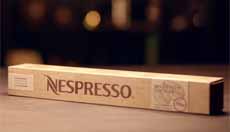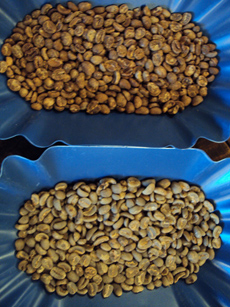TIP OF THE DAY: Aged Coffee & Nespresso Limited Edition Selection Vintage 2014
|
Conventional coffee advice tells you to buy the freshest roasted beans, and grind them as you need to make coffee. Don’t buy more than you need for the week: Fresh is everything.
But now, there’s aged coffee, a growing trend. Aged coffee is not analogous to old, stale, flat coffee. It comprises specially selected beans, that are aged using techniques that bring out the best aged qualities. While the marketing message compares aged coffee to aged balsamic vinegar, whiskey, wine, etc., that’s an apples-to-oranges comparison. Still, aged coffee isn’t exactly new. The first coffee drunk by Europeans was aged. THE HISTORY OF AGED COFFEE Venetian traders first brought coffee to Europe in 1615, but it wasn’t a “quick trip” from Venice. At the time, all imported coffee beans came from the port of Mocha, in what is now Yemen. It traveled south by ship around the Cape of Good Hope, then all the way up the west coast of Africa, continuing northward to England. By the time the coffee arrived, exposure to salt air over time significantly changed the taste of the coffee. When coffee was subsequently grown in Indonesia, the voyage was even longer. Europeans came to prefer the flavor over “fresh” coffee. In fact, when the Suez Canal opened in 1869, greatly shortening the voyage, Europeans still preferred the aged coffee to the fresher beans. And so it came to be that some coffee was intentionally aged for six months or longer in large, open-sided warehouses in shipping ports—plenty of salty ocean air to transform the beans. Over time, preferences changed. Fresh coffee beans became the preferred type of coffee in Europe, the U.S. and elsewhere. However, everything old is new again, and aged coffee has become the old new style to try. Here’s more history of coffee. AGED COFFEE HAS BEEN IN THE U.S. FOR A WHILE Starbucks has been aging coffee for certain single-origin coffees and for signature blends, such as Anniversary Blend and Christmas Blend. At Peet’s, you can find Aged Sumatra Coffee. Boutique producers also have introduced customers to the joys of aged coffee. Ceremony Coffee in Annapolis has a Barrel Aged Coffee Series. Water Avenue Coffee in Portland, Oregon sells Oak Barrel Aged Sumatra Coffee and Pinot Noir Barrel Aged El Salvador Coffee. So is aged coffee a connoisseur product, or a marketing throwback to the past? It is definitely the former! Everyone who savors a full-bodied cup of coffee black should try it. Why black? Well…add too much milk and sugar and you won’t taste the marvelous nuances. What To Know About Aged Coffee |

[1] A glass of Nespresso aged coffee from the 2014 vintage (photo courtesy Nespresso). [2] Sumatra coffee beans: aged (top) versus unaged (photo courtesy Starbucks Melody). [3] Roasted and ready to grind (photo © Nebojsa Rozgic). |
|
|
|
||

|
HOW TO CREATE AGED COFFEE Beans with the promise to age well are carefully aged under conditions that are best for the particular type of bean and vintage. As with many agricultural products, the “terroir” of the bean—the type of land, climate, seasonal weather and other environmental factors—produces different flavors and aromas in the finished product. After harvesting, the beans are bagged in burlap and regularly rotated to distribute moisture and prevent mold and rot. Some roasters prefer to age the beans in wine or whiskey barrels to impart still more flavors and aromas to the finished beans. The beans are usually aged at their origin, often at a higher altitude, where the temperature and humidity are more stable. Aging time ranges from six months to three years. Samples are roasted and brewed several times a year during the aging process and when the desired flavors have been achieved, are roasted after they are finished aging. A dark roast is best, as it evens out the flavor and accentuates the body of the coffee. Sometimes they are blended with other aged beans. However, some connoisseurs prefer a light roast on single-origin aged coffees, which better emphasizes the single-origin qualities. |
|
|
As more people embrace aged coffee, no doubt, there will be options to everyone’s taste. INTRODUCING NESPRESSO’S FIRST AGED COFFEE: For the first time, super-premium coffee brand Nespresso now offers coffee lovers the chance to taste aged coffee. After years of development and expertise, Nespresso experts selected Arabica beans from the highlands of Colombia, which promised to age well. These beans, from the 2014 harvest, were then stored under controlled conditions for two years. They were then ready to roast. The experts selected a sophisticated split roasting technique: One part of the beans was roasted lighter to protect the elegant aromas specific to these beans; the other part was roasted darker to reveal the maturity of the taste and enhance the richness of the texture. The result: a cup of espresso that is rich in body, mellow in flavor and velvety-smooth in texture. An elegant woodiness is layered with fruity notes. The goal—to create a new sensory experience for coffee aficionados—has been achieved! The aged coffee is a real treat—and a great gift idea. Don’t let this limited edition slip through your fingers. Get yours now, in either original or Vertuo capsules. Then, we can both look forward to the next aged vintage! More than 40 countries around the world grow coffee. How many can you name? (The answer.) |
||


